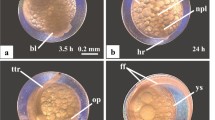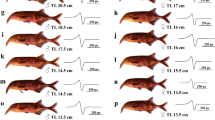Abstract
Reciprocal hybrids between tench Tinca tinca (L.) and carp Cyprinus carpio L., and tench and bream Abramis brama (L.) were produced artificially. The survival of all these hybrids during embryogenesis was quite high. The highest survival rate (over 60%) at the eyed stage was observed for tench and bream hybrids (both sex combinations). The hatching rates of these hybrids were also over 60%. The number of larvae with some abnormalities (i.e. deformed body) was low. In contrast, the hatching rates of tench and carp hybrids were very low (0.2%). From over 1000 fertilized eggs, only three specimens started swimming, and only one specimen survived to juvenile stage. Embryos of hybrids and their parental species differ in morphological features. These differences were also visible in the juveniles. Body parameters of juvenile hybrids produced from three species had intermediate values in comparison to parental fish.
Similar content being viewed by others
References
Bakos J., Krasznai T., Marian T. (1976). Investigations on cross-breeding and interspecies hybrids of the more important cyprinids in fish-farming. Halaszat 22:17-19 (In Hungarian)
Bakos J., Krasznai T., Marian T. (1978). Cross-breeding experiments with carp, tench and Asian phytophageous cyprinids. Aquacultura Hungarica (Szarvas) 1:51–57
Barth T., Kouril J., Hamackova J., Velek J., Barthova J., Hulova I., Jezek J., Pospisek J. (1997). Induced ovulation and artificial stripping in tench Tinca tinca (L.) and other freshwater fish species by means of GnRH analogues. Czech experiences 1980–1996. A minireview. Polish Archives of Hydrobiology 44:183–190
Brylinska M., Brylinski E., Bninska M. (1999). Tinca tinca Linnaeus, 1758. In: Banarescu P. (ed). The Freshwater Fishes of Europe Vol. 5/I. Aula-Verlag GmbH, Wiebelsheim, pp. 229–302
Flajshans M., Rab P., Dobosz S. (1992). Frequency analyses of active NORs in nuclei of artificially induced triploid fishes. Theoretical and Applied Genetics 85:68–72
Flajshans M., Kocour M., Gela D., Piackova V. (2004). The first results on relationships among amphimictic diploid, diploid gynogenic and triploid tench, Tinca tinca L. under communal testing. Aquaculture International 12:103–118
Howell W.M., Black D.A. (1980). Controlled silver-staining of nucleous organizer regions with a protective colloidal developer. Experientia 36:1014–1015
Kucharczyk D. (2002). Artificial spawning and androgenesis of some cyprinids. Dissertations and Monographs, 63: 1–80 (In Polish with English Summary)
Kucharczyk D., Jankun M., Luczynski M. (1997). Ploidy level determination in genetically manipulated bream, Abramis brama, based on the number of active nucleoli per cell. Journal of Applied Aquaculture 7:13–21
Kucharczyk D., Woźnicki P., òuczyński M.J., Klinger M. and Luczynski M. (1999). Ploidy level determination in genetically manipulated northern pike based on the number of active nucleoli per cell. North American Journal of Aquaculture 61:38–42
Kujawa R., Kucharczyk D. (1996). A method of in vivo designating oocytes from cyprinid and percid fish using catheter. Komunikaty Rybackie 4:20–21 (In Polish)
Kujawa R., Kucharczyk D., Mamcarz A. (1999). A model system for keeping spawners of wild and domestic fish before artificial spawning. Aquacultural Engineering 20:85–89
Linhart O., Kvasnicka P., Flajshans M., Kasal A., Rab P., Palecek J., Slechta V., Hamackova J., Prokes M. (1995). Genetic studies with tench, Tinca tinca L.: induced meiotic gynogenesis and sex reversal. Aquaculture 132:239–251
Nikolyukin N.I. 1952. Interspecific Fish Hybridization. Saratovskoye Oblastnoye Gosudarstvennoye Izdatelstvo, Saratov, 312 p. (In Russian)
Phillips R. B., Zajicek K.D., Ihssen P.E., Johnson O. (1986). Application of silver staining to the identification of triploid fish cells. Aquaculture 54:313–319
Ryabov N.N. (1979). Hybridisation of the representatives of different subfamilies of the Cyprinidae family. Voprosy Ikhtyologii 19: 1025–1042 (In Russian with English Summary)
Sakun O., Butskaya N. (1968). Designation of Maturity Stages and Study on Sexual Cycles of Fishes. PINRO, Murmansk, 48 p. (In Russian)
Viktorovskij R.P. (1966). Morphological characteristic of carp (Cyprinus carpio L.)×tench Tinca tinca (L.) hybrids. Izvestija GOSNIORKh, 61:136–142 (In Russian with English Summary)
Author information
Authors and Affiliations
Corresponding author
Rights and permissions
About this article
Cite this article
Mamcarz, A., Kucharczyk, D. & Kujawa, R. Reciprocal hybrids of tench Tinca tinca (L.) × bream Abramis brama (L.), and tench × carp Cyprinus carpio L., and some characteristics of their early development. Aquacult Int 14, 27–33 (2006). https://doi.org/10.1007/s10499-005-9011-4
Received:
Accepted:
Published:
Issue Date:
DOI: https://doi.org/10.1007/s10499-005-9011-4




